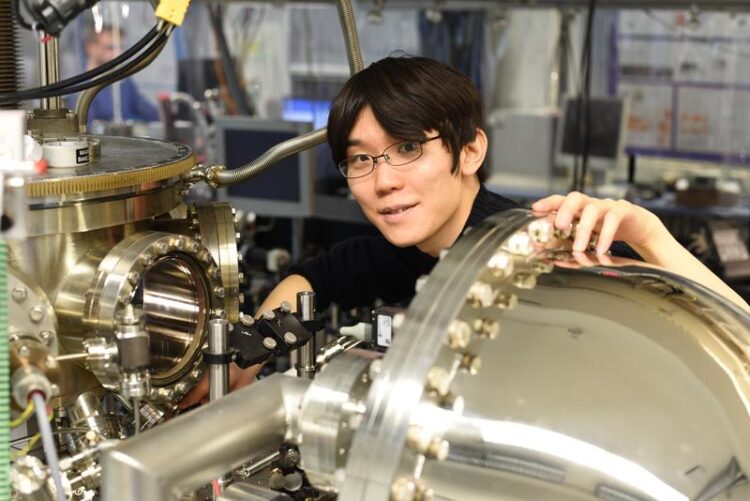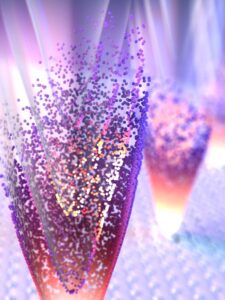Lightly dressed

Marburg physicist Dr. Suguru Ito performed the measurements on an ultra-high vacuum apparatus that demonstrated the rapid build-up of exotic quantum states.
(c) Jens Güdde
A team of physicists watches electrons getting dressed with light.
Since ancient times, mankind has tried to tailor materials by combining different substances. Imagine a world where materials properties could be flexibly changed on demand by simply shining light onto them. A group of physicists from across Europe has now made a decisive step towards this goal by dressing electrons moving in a solid with light.
The team, which includes researchers from the Universities of Regensburg and Marburg, the Max Planck Institute for Structure and Dynamics of Matter in Hamburg, the Paul Scherrer Institute in Villigen, Switzerland, and others, observed for the first time how exotic states, known as Floquet bands, arise in a crystal. The discovery, which has been published in the research journal “Nature”, could revolutionize the way we think about material properties.
“The discovery of new material properties usually depends on our ability to control the chemical composition of the material,” said Marburg physicist Prof. Dr. Ulrich Höfer, a lead author of the paper who also holds an adjunct professorship at University of Regensburg. “Purely optical manipulation of material properties could take physics into a new era by enabling new functionalities on demand.”

(c) Brad Baxley (parttowhole.com)
The team used the method of angle-resolved photoemission spectroscopy to study the surface electrons of the topological insulator bismuth telluride. In this material, the electrons can move ballistically for long times without scattering. By employing intense light pulses, the researchers could drive these electrons periodically through the crystal. This led to an exotic quantum effect, causing the electrons to have not just one fixed energy state, but many energy states evenly spaced apart by the driving photon energy. These so-called Floquet bands are hybrids between electrons and light. “However, the dynamic properties of such states have remained elusive until now,” explains Regensburg physicist Prof. Dr. Rupert Huber, another lead author.
The team’s measurements went far beyond the limit of what could be achieved to date with this technique. They managed to take actual videos of the moving electrons with a time resolution better than a single oscillation cycle of the electromagnetic carrier wave of light. As a result, they made an unforeseen discovery: “Surprisingly, Floquet bands form already after a single optical cycle,” says Dr. Suguru Ito, the first author of the publication. “Our experiment opens up the possibility of visualizing a large number of transient quantum states,” adds Huber. “This paves the way to tailored quantum functionalities and ultrafast electronics.”
The experimental findings are supported by theoretical modeling contributed by Dr. Michael Schüler of the Paul Scherrer Institute in Villigen, Switzerland, and Dr. Michael Sentef of the Max Planck Institute for Structure and Dynamics of Matter in Hamburg, Germany. The German Research Foundation funded participating scientists through Collaborative Research Centers in Marburg and Regensburg and through the Emmy Noether program. Several international funding organizations provided further financial support.
Having established the fundamental time limit for light-induced material engineering, the team’s breakthrough discovery could lead to a new era of materials science, enabling the creation of new functionalities on demand. Following this avenue, Prof. Dr. Ulrich Höfer and Prof. Dr. Rupert Huber were recently jointly awarded an ERC Synergy Grant from the European Research Council for their “Orbital Cinema” research project, which aims to take slow-motion videos of electronic motion in quantum mechanical orbitals of single molecules and atoms.
Wissenschaftliche Ansprechpartner:
Professor Dr. Ulrich Höfer
Philipps-Universität Marburg
Fachbereich Physik
Arbeitsgruppe Oberflächendynamik
Tel.: +49 (0)6421 28-24215
E-Mail: Hoefer@physik.uni-marburg.de
Professor Dr. Rupert Huber
Universität Regensburg
Institut für Experimentelle und Angewandte Physik
Arbeitsgruppe Ultraschnelle Quantenphysik und Photonik
Tel.: +49 (0)941 943-2070
E-Mail: rupert.huber@physik.uni-regensburg.de
Originalpublikation:
S. Ito, M. Schüler, M. Meierhofer, S. Schlauderer, J. Freudenstein, J. Reimann, D. Afanasiev, K. A. Kokh, O. E. Tereshchenko, J. Güdde, M. A. Sentef, U. Höfer, R. Huber, „Build-up and dephasing of Floquet-Bloch bands on subcycle timescales“, Nature (2023). DOI: 10.1038/s41586-023-05850-x
https://doi.org/10.1038/s41586-023-05850-x
Media Contact
All latest news from the category: Physics and Astronomy
This area deals with the fundamental laws and building blocks of nature and how they interact, the properties and the behavior of matter, and research into space and time and their structures.
innovations-report provides in-depth reports and articles on subjects such as astrophysics, laser technologies, nuclear, quantum, particle and solid-state physics, nanotechnologies, planetary research and findings (Mars, Venus) and developments related to the Hubble Telescope.
Newest articles

First-of-its-kind study uses remote sensing to monitor plastic debris in rivers and lakes
Remote sensing creates a cost-effective solution to monitoring plastic pollution. A first-of-its-kind study from researchers at the University of Minnesota Twin Cities shows how remote sensing can help monitor and…

Laser-based artificial neuron mimics nerve cell functions at lightning speed
With a processing speed a billion times faster than nature, chip-based laser neuron could help advance AI tasks such as pattern recognition and sequence prediction. Researchers have developed a laser-based…

Optimising the processing of plastic waste
Just one look in the yellow bin reveals a colourful jumble of different types of plastic. However, the purer and more uniform plastic waste is, the easier it is to…


